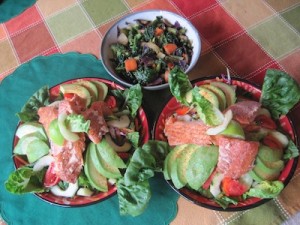Most of us now know that omega 3 fatty acids are seriously lacking in the standard American diet. They’re very important for brain and nerve function, heart health, beautiful skin, strong immunity, hormone balance, anti-inflammatory effects, anti-cancer effects, and many other bodily functions. Indigenous people’s diets are rich in omega 3s because the fats, oils, nuts, seeds, and grains they eat are fresh, whole, and unrefined.
The refining process that ingredients in packaged, fast, and restaurant foods go through exposes the fats in these foods to heat, pressure, and oxygen, which causes them to change molecularly and sometimes oxidize, or “go rancid”, which eradicates the benefits of the omega 3s in these foods.
Omega 3 fatty acids like EPA (eicosapentaenoic acid) and DHA (docohexaenoic acid) are used by the body to create prostaglandins; hormone-like substances which initiate all the beneficial bodily effects listed above. Prostaglandins play a crucial role in the regulation and optimal functioning of every cell and organ. Wow!
There are 2 different types of omega 3 fatty acids: plant-based and animal-based. From my study and experience, I’ve come to understand the difference between the two, and…
Which type of omega 3 supplement benefits which type of person:
Plant-based omega 3 rich seeds like fresh, raw flax seeds, chia seeds, hemp seeds, borage seeds, pumpkin seeds, and walnuts are most easily used by the body to create EPA and DHA, and to then create prostaglandins, by people who’ve eaten a healthy, whole food diet for most of their lives. You see, their bodies aren’t underperforming from years of eating processed, de-natured foods, so they can easily convert the ALA (Alpha-Linoleic Acid) found in these plant-based omega 3-rich foods into EPA and DHA.
Animal-based omega 3s provide a direct source of EPA and DHA for those of us who’s bodies are still recovering from years on the standard American diet; foods such as krill, wild caught salmon, sardine, tuna, lake trout, eel, anchovy, and butterfish. Mother’s milk is another direct source of EPA and DHA.
This leads to the question; are there any safe sources of fish these days? Levels of heavy metals like mercury have been known to be sky high in ocean fish since the 90‘s. Generally, smaller types of fish like sardines and anchovy have less mercury, because they don’t grow large enough to consume other, mercury-laden fish. Also, bottom feeders and shellfish are extremely high in heavy metals because these elements sink to the ocean floor. Depending on how clean the water certain fish live and grow in is, consciously raised, freshwater fish are considered safest at this point. I love the non-GMO fed and non-fish-by-product fed catfish and tilapia available at natural food stores. Also, Vital Choice salmon is excellent, and can be ordered online….
I buy a krill oil supplement from Mercola.com, which is, I’ve found, better than fish oil supplements for many reasons. Krill oil is more efficiently utilized by the body than fish oil, so only 1/3 as much of it is needed (1tsp krill oil daily vs. 1Tbsp of fish oil). Krill oil contains asthaxanthin, a powerful antioxidant which can reverse cancer, counteract inflammation, and slow aging. Krill oil is much more sustainably harvested because there is an abundance of plankton (krill) in the ocean, whereas more and more kinds of fish are becoming “fished out”, or scarce these days. And, something many people love about krill oil, is that it doesn’t give you fishy smelling burps after you take it. Yay!
My personal experience with omega 3 supplements is telling. I had acne starting when I was 15, and into my 20s, I still had acne! Adult acne runs on my Dad’s side of the family. At age 23, I went to see a naturopath, and she told me that I needed fish oil. She explained that, genetically, my skin doesn’t produce the kind of oil which keeps my pores clear. I started taking a daily tablespoon of Carlson’s classic cod liver oil, and it took three months, but my skin cleared up for good. I was then able to reduce my dose to a teaspoon every other day to maintain my complexion. A few years ago, I switched to taking Mercola’s krill oil “caplique” (small capsule) every other day, and have enjoyed the same effect. These days, I like to get BOTH animal sourced and plant sources omega 3s into my body. So, about 3 times per week, I soak about 3Tbsp of chia or flax seeds to munch while I’m cooking. I love the regulating effect these seeds have on my digestion and bowel transit time…keeping my bowls moving regularly keeps my system less burdened by toxins, and helps me feel more energetic.
Concerning fish or krill oil supplements, I recommend spending the money on the more expensive brands that have been cleaned and tested for heavy metals and other pollutants. I consider the extra money I spend on quality foods and supplements, to be my health insurance.
For helpful articles by Dr. Mercola, a New York Times bestselling author, please visit Mercola.com today and receive your FREE Take Control of Your Health E-book!

